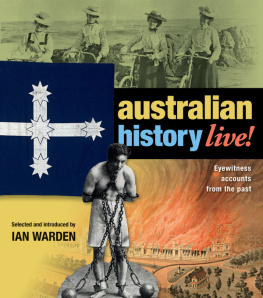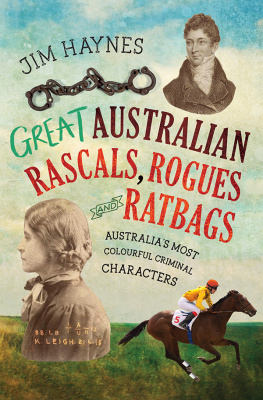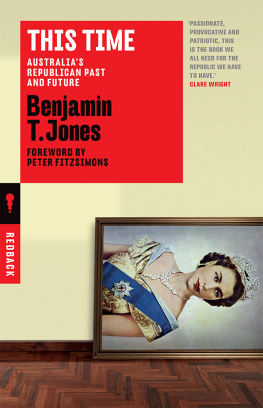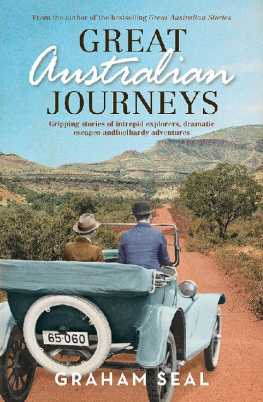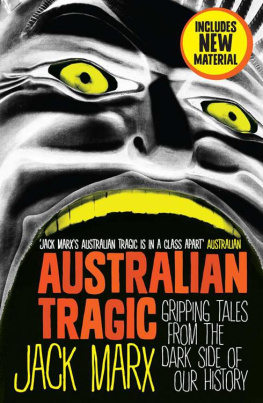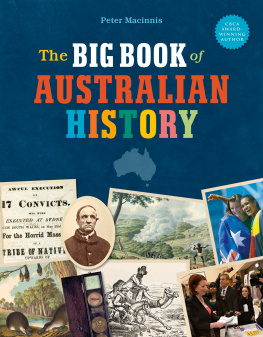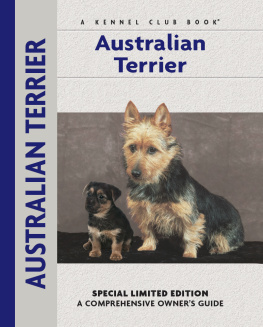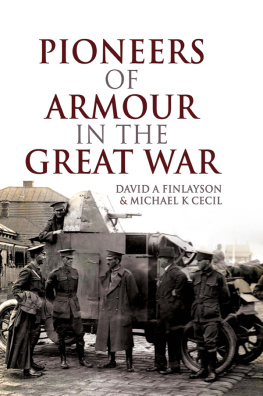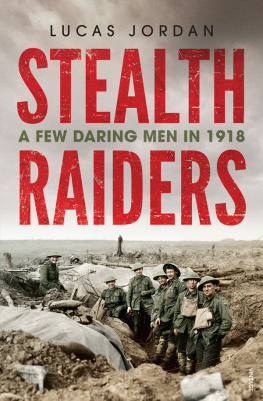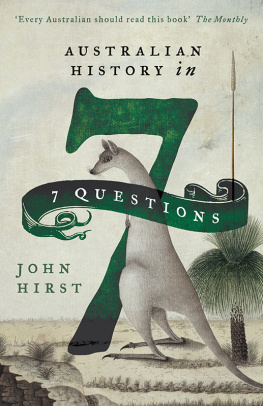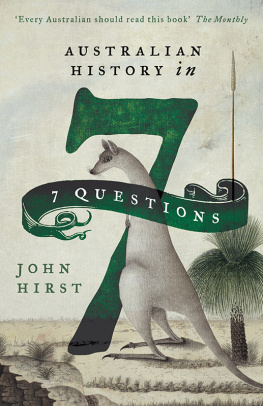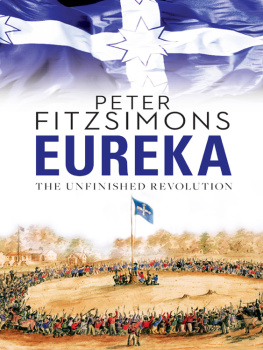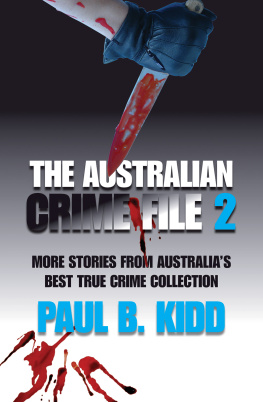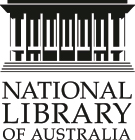Published by the National Library of Australia
Canberra ACT 2600
National Library of Australia 2013
Introduction and commentary Ian Warden
Books published by the National Library of Australia further the Librarys objectives to interpret and highlight the Librarys collections and to support the creative work of the nations writers and researchers.
Every reasonable endeavour has been made to contact the copyright holders. Where this has not been possible, the copyright holders are invited to contact the publisher.
Indigenous and Torres Strait Islander communities should be aware that this book contains images and names of people who are now deceased.
Editorial note: quotes from original documents are in the language as used in the recorded source.
This book is copyright in all countries subscribing to the Berne Convention. Apart from any fair dealing for the purpose of research, criticism or review, as permitted under the Copyright Act 1968, no part may be reproduced by any process without written permission. Enquiries should be made to the publisher.
The views expressed in this book are those of the individual author/s and do not necessarily reflect the views of the editors or the publisher.
National Library of Australia Cataloguing-in-Publication entry
Author: Warden, Ian, 1945
Title: Australian history live! : eyewitness accounts from the past / Ian Warden.
ISBN: 9780642277602 (epub.)
Notes: Includes bibliographical references and index.
Subjects: Australia--History
Australia--History--Sources.
Clippings (Books, newspapers, etc.)
Other Authors/Contributors:
National Library of Australia.
Dewey Number: 994
Commissioning Publisher: Susan Hall
Editor: John Mapps
Designer: Noel Wendtman
Image Coordinator: Jemma Posch
Production: Melissa Bush
Printer: Everbest
NLA Publishing would like to thank George Nichols for his help with this publication.
Find out more about National Library Publishing at http://publishing.nla.gov.au
australian
history live!
Eyewitness accounts from the past
Selected and introduced by
IAN WARDEN
NLA PUBLISHING
Introduction
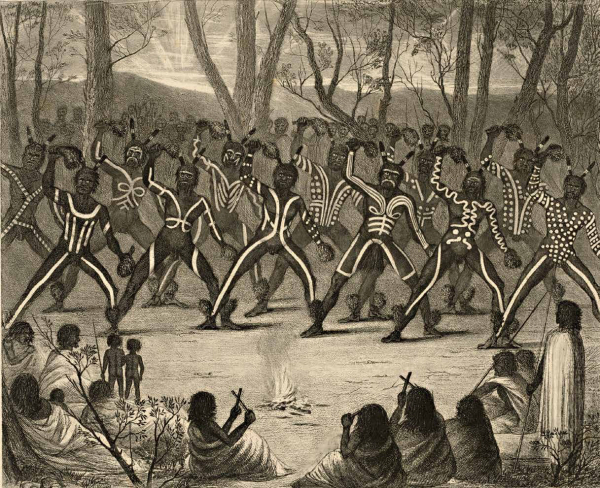
J. Redaway & Sons (engraver), William Blandowski (artist, 18221878) Aborigines of Australia, Corrobori or Native Festival 1855 or 1856
Is time travel to the past possible? Stephen Hawking doesnt think so, since we never seem to meet tourists who are visiting us from the future. But Carl Sagan wonders:
it might be that time travel into the past is possible, but they havent gotten to our time yet, theyre very far in the future and the further back in time you go, the more expensive it is They can come to as far back as whatever it would be, say AD 2300, but not further Perhaps we can achieve a kind of time travel, inexpensively too, back to the past. With a little help from our imaginations, the best eyewitness descriptions of past occasions enable us to do some time-travelling.

Rotary Photographic Co. (Firm)
Mme. Melba c. 1907
This book is a collection of virtual time-travellings back to occasions great and minor in Australias past. Those of you who hold this twenty-first-century book in your twenty-first-century hands will never be thrilled by the actual sights and sounds of a full-bloodedly authentic Aboriginal corroboree, will never actually see the Great Comet of 1843 and will never actually see and hear Nellie Melba singing at her majestic best. But long-dead others saw and heard these phenomena and have reported them exquisitely in ways that put us there with themthe reporters.
John Careys The Faber Book of Reportage (1987) is an enormous 700-page collection of reportage across history, beginning in Athens in 430 BC. In the introduction, Carey writes: All knowledge of the past which is not just supposition derives ultimately from people who can say I was there. Whats more, writes Carey: eye-witness accounts have the feel of truth unlike objective or reconstituted history, which is laborious but dead. Carey required everything in The Faber Book of Reportage to pass some tests before inclusion. Likewise, everything in this book had to impress with its qualifications. Firstly, and perhaps most importantly, the piece had to be good enough to enable readers to do the virtual time travel and to feel that they, too, are there, seeing and feeling what the reporter saw and felt. The best eye-witness reporting achieves this quite magically, in ways we shouldnt overanalyse because that magic is usually much, much more than terrific reporting technique. Indeed some of the best pieces are by people who gave little thought to technique but who just burbled amateurishly about what theyd seen.
Reporters, whether they be professional and amateur, polished and unpolished, always do their best work when theyre truly thrilled, astonished or shaken. For example, the success of Captain John Hunters description in transporting us to the corroboree he attended in 1791 owes lots to the pleasure and excitement the occasion stoked in him. Hunters description also illustrates that the very best eyewitness reporting can come with reporting of, as well, what the eyewitness heard. Thus, the corroboree report is rich in both sights and sounds.
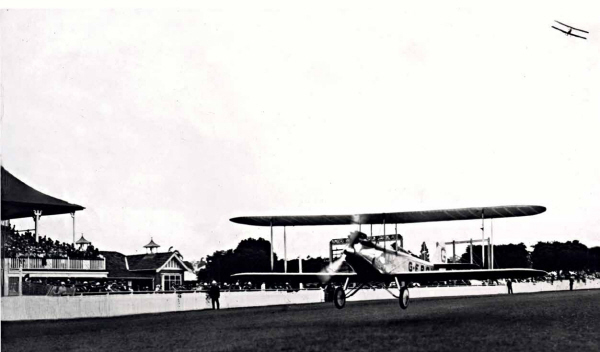
Cliff Postle (19132004) Bert Hinkler Lands at Eagle Farm Racecourse in His Avro Avian during a Race Meeting, Queensland 1928
Eyewitnesses take their noses with them too. Louisa Anne Meredith, for instance, reports how branches of Christmas bush cut to deck Australian halls (there being no holly in the colony) smelt of new-mown hay. And William Hobbs cant stay to make a painstaking account of the dead of the Myall Creek massacre because the stench drives him away.
Another kind of book might attempt a kind of eyewitness history of Australia that just concentrates on obviously important events. In this book, although there are some pieces about some great occasions, the quality of the putting-us-thereness of the piece has been the paramount qualification. And so, for example, Bernard OReillys rapturous description of just another breaking of just another drought (which leaves the reader feeling soaked to the skin by the welcome rain) chose itself. So did Francis Ratcliffes description of the experience of being caught in a willy-willy (which leaves the reader feeling filthy with dust).
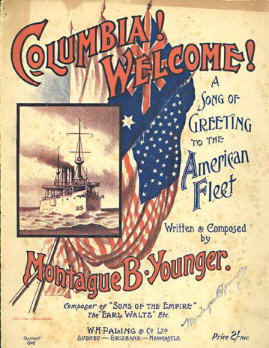
Montague B. Younger Columbia! Welcome! A Song of Greeting to the American Fleet c. 1908
This collection of Australian occasions errs on the side of eyewitness descriptions that pack a punch. The wallop may be because of quirkiness, starkness or even tragedy. Deep within this collection of eyewitness reports, the reader will come across descriptions of a bewildered little terrier dog refusing to leave the much-bayoneted dead body of its master just killed at the Eureka Stockade.
The sight of it scalded the memories of everyone who saw it. The fact that Careys collection has a description of Mary Queen of Scots tiny dog found hiding in its just-beheaded mistress skirts gives this books little dog at Eureka authoritative approval. Small things like an animals grief in the shadow of the colossal awfulness of Eureka (or of the beheading of a monarch) are sideshows incidental to great events. But its those small things that seem to humanise that greatness and help make it lifesized after all.

